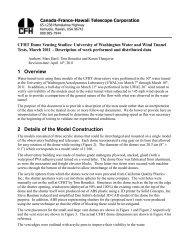ALLEN BRADLEY 1747-L551 PLC Processor
ALLEN BRADLEY 1747-L551 PLC Processor
ALLEN BRADLEY 1747-L551 PLC Processor
Create successful ePaper yourself
Turn your PDF publications into a flip-book with our unique Google optimized e-Paper software.
8–2<br />
Starting Up Your Control System<br />
1. Inspect Your<br />
Installation<br />
You can often prevent serious problems in later test procedures by<br />
first making a thorough physical inspection. We recommend that<br />
you do the following:<br />
1. Make sure that the controller and all other devices in the system<br />
are securely mounted.<br />
2. Check all wiring including:<br />
• connections from the main disconnect to the controller input<br />
• the master control relay/emergency-stop circuit<br />
• input device circuits<br />
• output device circuits<br />
Make certain that all wiring connections are correct and that there<br />
are no missing wires. Check the tightness of all terminals to<br />
make certain wires are secure.<br />
3. Measure the incoming line voltage. Be certain that it corresponds<br />
to controller requirements and that it falls within the specified<br />
voltage range. See specifications for input voltage ranges on<br />
page 2–11.<br />
2. Disconnect<br />
Motion-causing Devices<br />
In the following test procedures, the controller is energized. As a<br />
safety precaution, you must make certain that machine motion does<br />
not occur. The preferred way is to disconnect the motor wires at the<br />
motor starter or the motor itself. In this way, you can test the<br />
operation of the starter coil, verifying that your output circuit is<br />
wired correctly and functioning. Similarly, the preferred way to<br />
disconnect a solenoid is to disengage the valve, leaving the coil<br />
connected.<br />
In some instances, you may not be able to disconnect a device the<br />
preferred way. In this case, it is necessary to open the output circuit<br />
at some convenient point.<br />
For circuit testing purposes, it is best to open the circuit at a point as<br />
close as possible to the motion-causing device. For example, your<br />
output might be a relay coil that in turn energizes a motor starter; if it<br />
is impractical to disconnect the motor wires, the next best thing to do<br />
is to open the circuit at a point between the motor starter and the<br />
relay contact.<br />
!<br />
ATTENTION: Machine motion during system<br />
checkout can be hazardous to personnel. During the<br />
checkout procedures 3, 4, 5, and 6, you must<br />
disconnect all devices that, when energized, might<br />
cause machine motion.<br />
Publication <strong>1747</strong>-6.2




![Documentation [PDF] - Canada France Hawaii Telescope ...](https://img.yumpu.com/26965302/1/190x245/documentation-pdf-canada-france-hawaii-telescope-.jpg?quality=85)







